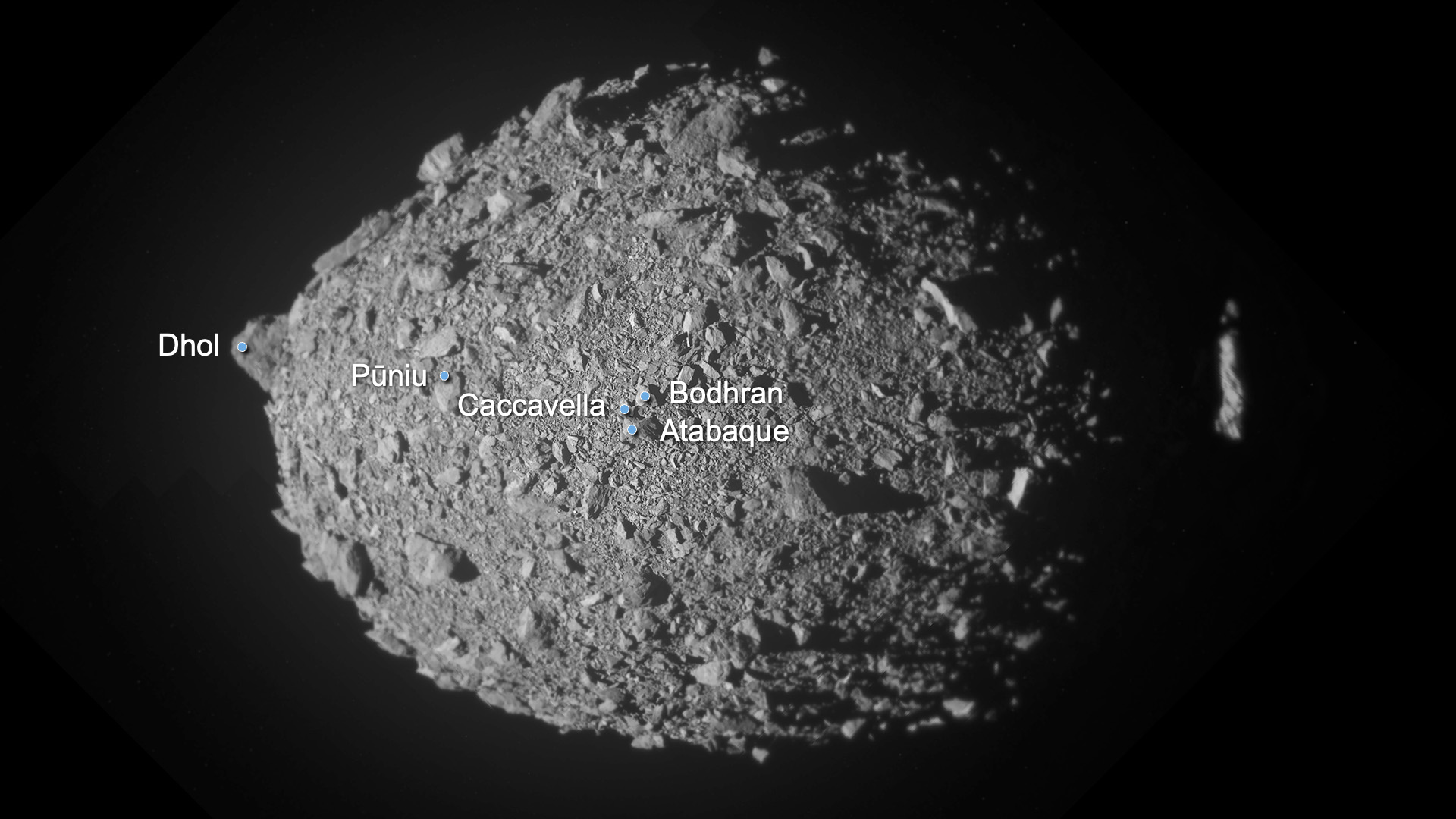NASA's asteroid-slamming DART mission completely changed the shape of its target
NASA's DART spacecraft seems to have completely reshaped asteroid Dimorphos after violently crashing into it in Sept. 2022

Scientists have discovered that the target asteroid of NASA's Double Asteroid Redirection Test (DART) may have been reshaped by the impact. A new investigation into the collision's aftermath revealed that the asteroid, which is the smaller component of a binary asteroid system, exhibits a loose "rubble-pile" composition.
DART slammed into the moonlet Dimorphos, which orbits the larger space rock Didymos, on Sept. 26, 2022. The aim of this cosmic assault was to see if a kinetic impact could shift an asteroid's trajectory around a larger object and verify that this method could be used to shunt a space rock someday if its path fell on a collision course with Earth.
Six months after the impact, NASA confirmed the mission had been successful, with the time it takes Dimorphos to orbit its larger asteroid companion reduced by 33 minutes. Post-impact, one of Dimorphos' orbits around Didymos takes about 11 hours and 23 minutes. And now, new research shows the impact may also have had major effects on the shape of Dimorphos.
A team led by University of Bern scientist Sabina Raducan used state-of-the-art computer modeling to first determine that Dimorphos is a loose, rubble-pile asteroid. This also means the moonlet may have formed from material that was ejected from its larger asteroid partner, Didymos.
The simulations that were the closest match to observations of the impact suggest Dimorphos is only weakly cohesive and has a lack of large boulders on its surface.
"Before DART's arrival at Dimorphos, we didn’t know what to expect. Because the system is so far away from Earth, Dimorphos was not properly resolved. Therefore, we could have encountered anything from a monolithic body — essentially a large boulder the size of Dimorphos — to a cohesionless rubble pile or anything in between," Raducan told Live Science's sister site Space.com. "So, while the impact outcome came as a surprise to most, it was one of the predicted scenarios."
Raducan added that, while preparedness meant the rubble-pile nature of Dimorphos wasn't too surprising, DART has revealed other things that did take the team off guard.
Get the world’s most fascinating discoveries delivered straight to your inbox.
"Dimorphos have a very different composition from asteroids Ryugu and Bennu, but their reaction to impacts, seeming to be very similar, was surprising," Raducan said. "For all of these asteroids, cratering occurs in a low-gravity, low-cohesion regime, where the crater grows many times larger than the projectile.
Plus, according to the team's calculations, rather than just creating an impact crater, the DART collision seems to have completely reshaped Dimorphos. This would've happened through a process called global deformation. In turn, the reshaping appears to have caused the exterior of the moonlet to be resurfaced with material from its interior.
The team's simulations showed that between 0.5% and 1% of Dimorphos' mass was ejected as a result of the DART impact, while 8% of its mass was redistributed, leading to significant reshaping and resurfacing of the asteroid. Raducan added that these findings suggest the structural integrities and responses to impacts of small asteroids are likely profoundly influenced by their internal compositions and the distributions of their constituent materials.
The team's results could help scientists better understand the Dimorphos and Didymos asteroid system as well as dissect the dynamics of other binary asteroids in the solar system.
"The material properties and structure of Dimorphos as derived in this study suggests the small moon likely formed through rotational mass shedding and re-accumulation from Didymos," Raducan said. "These findings offer clues about the prevalence and characteristics of similar binary systems in our solar system, contributing to our broader understanding of their formation histories and evolution."
The primary aim of DART was to test planetary defense methods, and Raducan said the mission has definitely delivered in this respect. She explained that these results will inform the development of future asteroid exploration missions and will have an impact on asteroid collision mitigation strategies, guiding the design of future planetary defense initiatives.
"The implication for planetary defense is that small, rubble-pile asteroids, like Dimorphos, are very efficient to deflect, and the kinetic impactor technique would be an appropriate deflection mechanism," Raducan said. "However, before attempting deflection, a reconnaissance mission would likely be necessary to accurately assess the asteroid's properties."
The researchers now plan to compare simulation results to data collected by the upcoming European Space Agency (ESA) Dimorphos-visiting mission, Hera, to validate and refine their models.
"The Hera mission's findings will be instrumental in validating our models and transforming a kinetic impactor into a reliable asteroid deflection mechanism," Raducan concluded. "We also plan to extend our analysis to a broader range of asteroid types and/or shapes, like Dinkinesh, as recently imaged by the Lucy mission.
"These studies will enhance the robustness of our predictions for planetary defense and contribute to a more comprehensive understanding of asteroid mechanics and composition."
The team's research was published on Monday (Feb. 26) in the journal Nature Astronomy.
Originally posted on Space.com.
Robert Lea is a science journalist in the U.K. who specializes in science, space, physics, astronomy, astrophysics, cosmology, quantum mechanics and technology. Rob's articles have been published in Physics World, New Scientist, Astronomy Magazine, All About Space and ZME Science. He also writes about science communication for Elsevier and the European Journal of Physics. Rob holds a bachelor of science degree in physics and astronomy from the U.K.’s Open University








